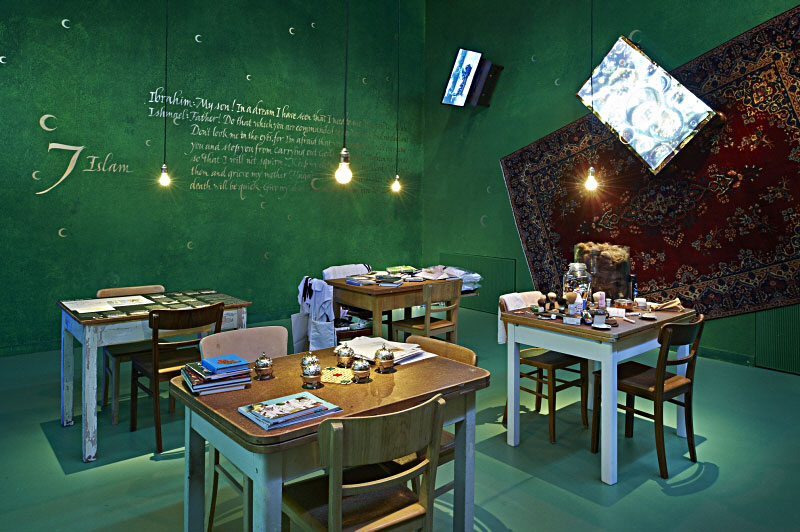The Many Faces of Isaac and Ismael, Part 2
As we recently announced, this month we would like to show another selection of clips from our video box, “Are you Isaac or Ismael?” This time, we’ve chosen clips of visitors who identify with both sons of Abraham. As one woman poetically put it: “Both are home within me.” That said, who were Isaac and Ismael exactly? And what is their importance in each of the three monotheistic religions?
Lisa Albrecht was again responsible for selecting the video clips. Now and then she’s also found sitting smiling near the video box.
In both Judaism and Christianity, Isaac is the first-born son of Abraham and Sarah. However, Abraham had already fathered a child with his Egyptian-born and second wife, Hagar, named Ismael. At this point, the biblical story reaches a dramatic climax, which is the subject of our exhibition “Obedience: An Installation in 15 Rooms by Saskia Boddeke & Peter Greenaway.” Hagar and Ismael were impugned and cast out into the desert.
In Chapter 22:2 of the first book of the Torah, God commands Abraham: “Take now thy son, thine only son, whom thou lovest, even Isaac, and get thee into the land of Moriah; and offer him there for a burnt-offering upon one of the mountains which I will tell thee of.” Abraham obeys, but is stopped at the last moment because an angel is convinced of Abraham’s obedience to God and sends a ram to take Isaac’s place.
Isaac goes on to become a patriarch of the People of Israel, along with his father Abraham and, later, his son Jacob. The “Binding of Isaac” has a fixed place in the Jewish liturgy of the high holidays of Rosh ha-Shanah (new year) and Yom Kippur (the day of atonement).

A view of the room, “Christianity,” in the “Obedience” exhibit
© Jewish Museum Berlin, photo: Yves Sucksdorff
In Christianity, Jesus is a direct descendant of Abraham through Isaac. Abraham’s willingness to sacrifice Isaac foreshadows Jesus’ crucifixion and resurrection. This biblical story also has a place in Christian liturgy and is retold during Easter.
In the Koran, the son who is almost sacrificed isn’t actually named. Since Ismael, as the forefather of the Arabs, is seen as Abraham’s firstborn, it is widely believed it is he whom God commanded to be sacrificed. More significant than the selection of the son is Islam’s feast of the sacrifice, which centers on the Abraham-Ismael story. This is a part of the Hajj – the pilgrimage to Mecca – and an animal sacrifice symbolizes the faith in God that is expressed by Abraham’s obedience. At the same time, the sacrifice is a charitable act, as the meat is divided among close family, relatives, and those in need.
The story of the binding of Isaac and Abraham’s (prevented) sacrifice is similar among the holy texts of the three monotheistic religions. It’s the interpretation, however, that differs significantly. While Abraham is a patriarch common to Judaism, Christianity, and Islam, his two sons, Isaac and Ismael, are considered ancestors and founders of different religions. As brothers, they are bound together but separated at the same time.
This parallel among difference is evident in the first room of “Obedience: An Installation in 15 Rooms by Saskia Boddeke & Peter Greenaway.” Countless young people identify with both sons. And as we’ve now shown, so do many of our visitors. What’s your perspective on the biblical story?
If you’d like to share your thoughts with us, come by the Eric F. Ross Gallery. We look forward to your visit!
Jihan Radjai, who contributed to the implementation of the video box, now marvels at our visitors’ active participation.

